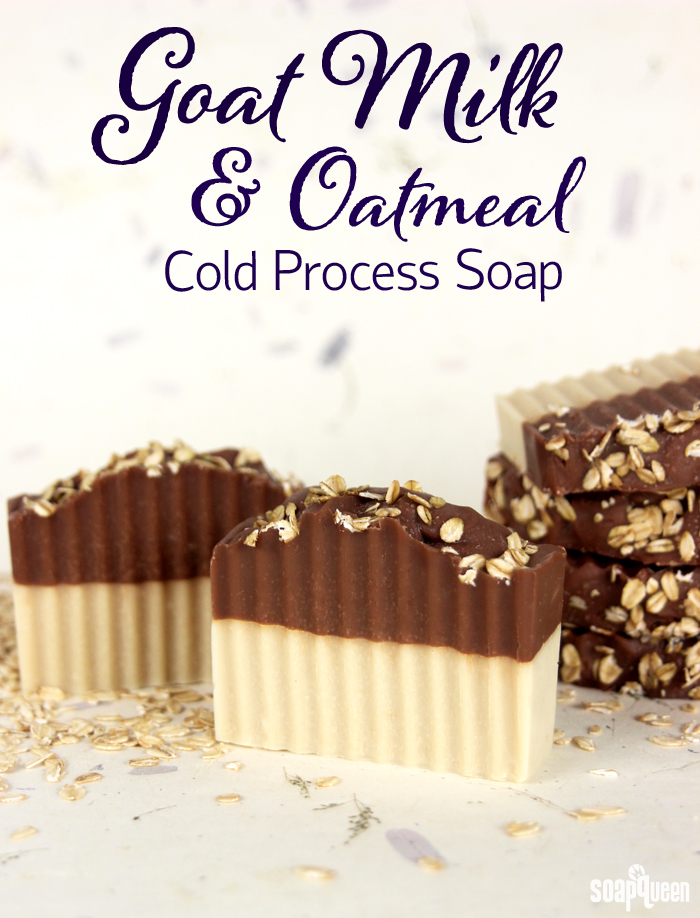 Goat milk may be the most popular type of milk when it comes to soap making. Moisturizing and nourishing, goat milk contains lactic acid which helps keep skin smooth by naturally exfoliating skin. Goat milk also contains vitamins A, D and B6. Many soap makers find fresh goat milk via local farms and markets, or raise their own goats. When fresh goat milk is unavailable, goat milk powder is a fantastic option. Simply add the goat milk to distilled water to reconstitute and receive all the skin loving benefits. For more information on working with milk in soap, check out this How to Add Lye to Milk post, and the Buttermilk Bastille Baby Bar video on Soap Queen TV.
Goat milk may be the most popular type of milk when it comes to soap making. Moisturizing and nourishing, goat milk contains lactic acid which helps keep skin smooth by naturally exfoliating skin. Goat milk also contains vitamins A, D and B6. Many soap makers find fresh goat milk via local farms and markets, or raise their own goats. When fresh goat milk is unavailable, goat milk powder is a fantastic option. Simply add the goat milk to distilled water to reconstitute and receive all the skin loving benefits. For more information on working with milk in soap, check out this How to Add Lye to Milk post, and the Buttermilk Bastille Baby Bar video on Soap Queen TV.
This Goat Milk and Oatmeal Cold Process soap is made with powdered goat milk, oat extract and colloidal oatmeal for a bar that is gentle on the skin. Colloidal oatmeal is extremely fine ground oatmeal that is fantastic for irritated or sensitive skin. Oatmeal, Milk and Honey Fragrance Oil gives this bar a warm and comforting scent. The fragrance also lends its vanilla discoloration to the top layer, which darkens the Brown Oxide used to color it. For more information on fragrance discoloration, click through the Why Did My Soap Turn Brown post.
What You’ll Need:
10″ Silicone Loaf Mold
3.5 oz. Sweet Almond Oil
1.7 oz. Castor Oil
10.5 oz. Coconut Oil
10.5 oz. Olive Oil
8.8 oz. Palm Oil
5 oz. Sodium Hydroxide Lye
11.5 oz. Distilled Water
2 oz. Oatmeal, Milk and Honey Fragrance Oil
1 Tbs. Oat Extract
Titanium Dioxide
Brown Oxide
Gold Sparkle Mica
Colloidal Oatmeal
Powdered Goat Milk
Oatmeal (for top)
Optional: Crinkle Cutter
 Click here to add everything you need for this project to your Bramble Berry shopping cart!
Click here to add everything you need for this project to your Bramble Berry shopping cart!SAFETY FIRST: Suit up for safe handling practices! That means goggles, gloves and long sleeves. Make sure kids, pets, and other distractions and tripping hazards are out of the house or don’t have access to your soaping space. Always soap in a well-ventilated area.
MILK PREP: Mix 1.5 oz. of goat milk powder into the distilled water. Once the powder is completely mixed into the water and contains no clumps, pour the milk into ice cube trays and place them into the freezer until completely hard (several hours to overnight).
COLOR PREP: To ensure that the Titanium Dioxide blends smoothly into the soap batter, we recommend micronizing it before dispersing it in oil. Please note this is an optional tip but it does help with the titanium dioxide clumping in the soap =) To micronize colorant, simply use a coffee grinder to blend the colorant to break up any clumps of color and prevent streaks of white from showing in the final soap. We like to use a coffee grinder that has a removable, stainless steel mixing area for easy cleaning. Then, disperse 1 teaspoons of the colorant into 1 tablespoon of sunflower or sweet almond oil (or any other liquid oil). Disperse 1 teaspoons of the brown oxide into 1 tablespoon light liquid oil. Then, disperse 1 teaspoon colloidal oatmeal into 1 tablespoon light liquid oil. Use a mini mixer to get the clumps of color worked out smoothly.
ONE: Remove the fully frozen milk from the ice cube trays and place into a container that has been placed in an ice bath. Slowly add lye and stir until the lye is fully dissolved and the milk has become liquid. Click here to see this process and more tips on creating a lye and milk mixture. The more slowly you add the lye, the cooler the temperature of this mixture will stay. This process will take at least 10 minutes. Make sure there are no undissolved lye bits. The lack of heat slows the process considerably. If you’d like a harder bar of soap that releases faster from the mold, you can add sodium lactate to the cooled lye milk. Use 1 teaspoon of sodium lactate per pound of oils in the recipe. For this recipe, you’d add about 2.5 tsp. sodium lactate.
TWO: Melt and combine the coconut oil, olive oil, castor, sweet almond oil and palm oils (remember to fully melt then mix your entire container of palm oil before portioning). Once the oils have cooled to 130 degrees or below, add the lye milk to the oils and stick blend until medium trace. Because this design is simple, a thicker trace than normal works great.
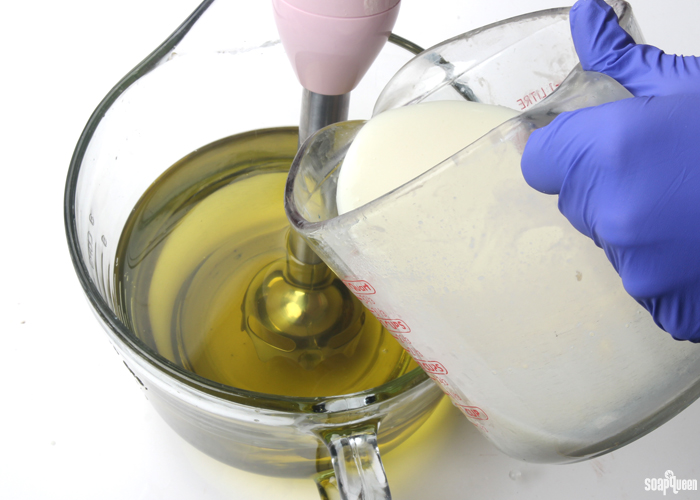
 THREE: Add 1 tablespoon of oat extract, and use a whisk to combine.
THREE: Add 1 tablespoon of oat extract, and use a whisk to combine.
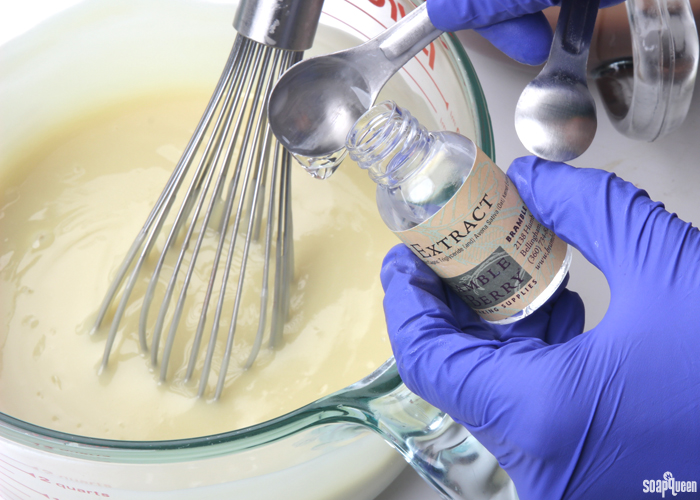 FOUR: Split the batch evenly into two containers. Each container will hold about 3 cups. To one container, add all of the colloidal oatmeal and titanium dioxide. Use a whisk to fully blend in.
FOUR: Split the batch evenly into two containers. Each container will hold about 3 cups. To one container, add all of the colloidal oatmeal and titanium dioxide. Use a whisk to fully blend in.
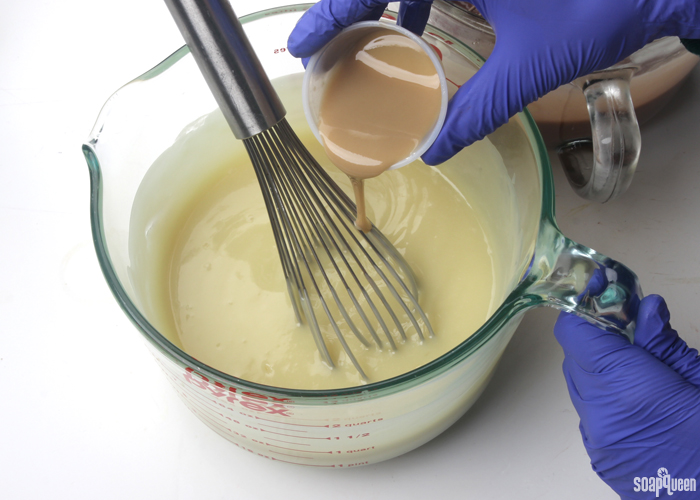
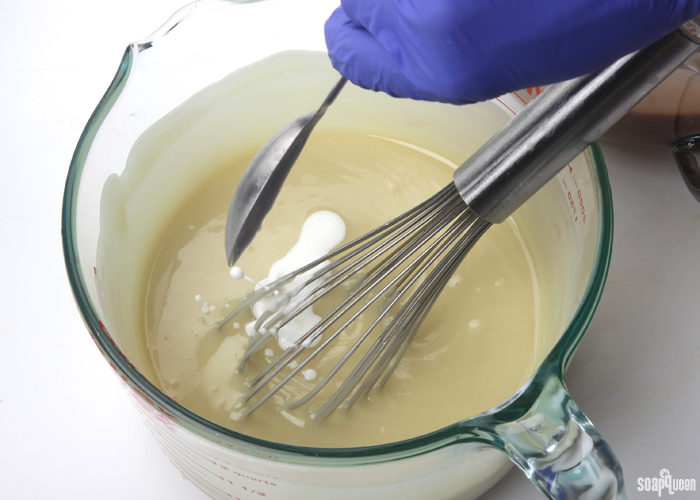 FIVE: To the other container, add 2 teaspoons dispersed brown oxide and all of the Oatmeal, Milk and Honey Fragrance Oil. Use a whisk to fully mix in.
FIVE: To the other container, add 2 teaspoons dispersed brown oxide and all of the Oatmeal, Milk and Honey Fragrance Oil. Use a whisk to fully mix in.
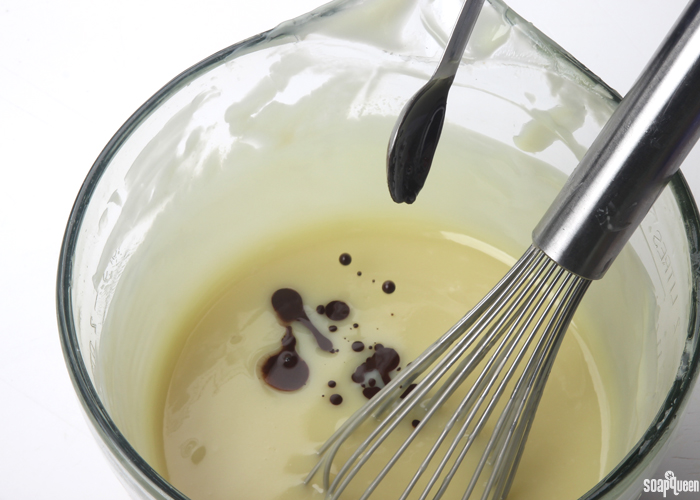 SIX: Pour the white soap into the mold, and firmly tap the mold onto the counter to evenly disperse the soap and get rid of air bubbles.
SIX: Pour the white soap into the mold, and firmly tap the mold onto the counter to evenly disperse the soap and get rid of air bubbles.
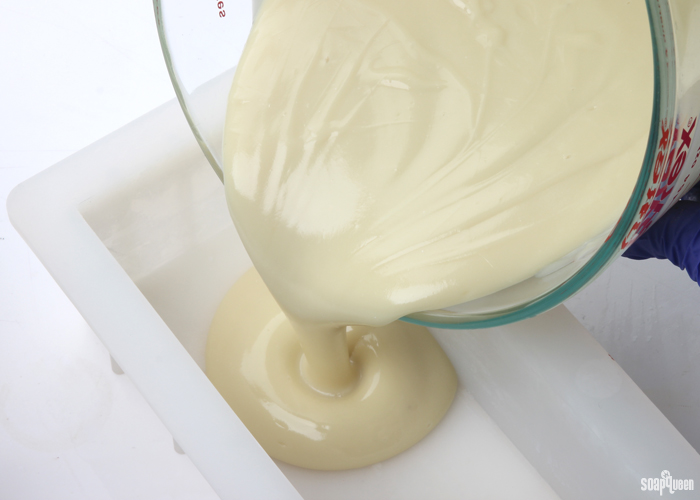 SEVEN: Use a powder duster to sprinkle on a thin layer of Gold Sparkle Mica. Don’t use too much, or the layers of soap may separate. Once the mica has been sprinkled on, close your eyes and gently blow on the mica to evenly disperse it.
SEVEN: Use a powder duster to sprinkle on a thin layer of Gold Sparkle Mica. Don’t use too much, or the layers of soap may separate. Once the mica has been sprinkled on, close your eyes and gently blow on the mica to evenly disperse it.
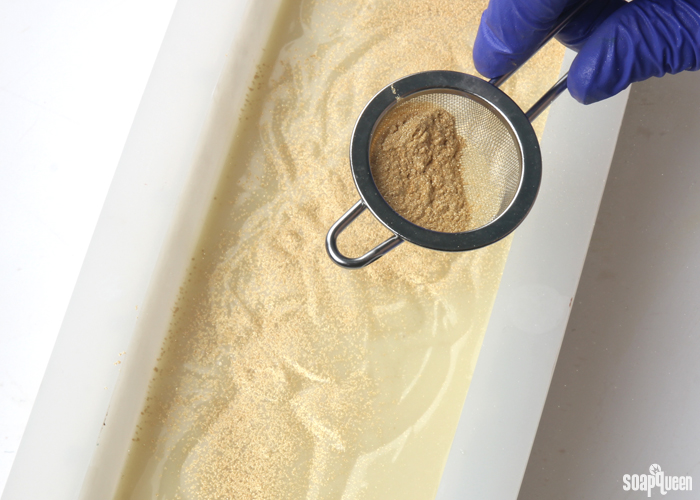 EIGHT: Slowly and carefully, pour the brown soap into the mold. Pour the soap over a spoon or spatula to make sure the soap does not break through to the white layer.
EIGHT: Slowly and carefully, pour the brown soap into the mold. Pour the soap over a spoon or spatula to make sure the soap does not break through to the white layer.
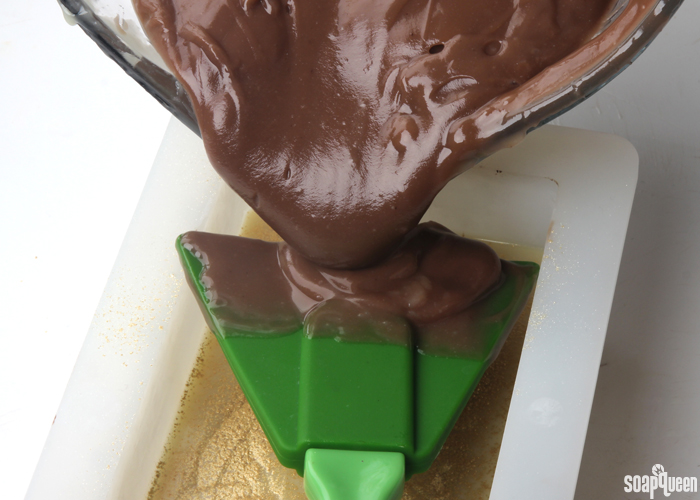 NINE: Gently tap the mold onto the counter to evenly disperse the soap in the mold. This also helps get rid of air bubbles.
NINE: Gently tap the mold onto the counter to evenly disperse the soap in the mold. This also helps get rid of air bubbles.
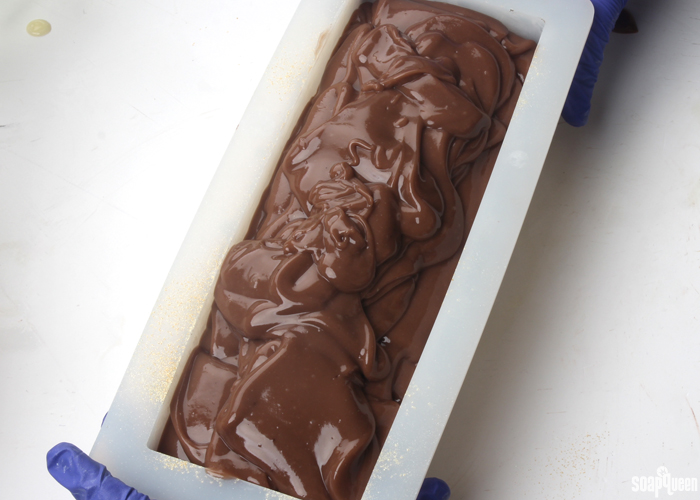 TEN: Use a spoon to create peaks and texture into the top of the soap.
TEN: Use a spoon to create peaks and texture into the top of the soap.
 ELEVEN: Sprinkle a layer of oatmeal on the top. Once you’re happy with the amount of oatmeal, spray the top with 99% isopropyl alcohol. Place the soap in the freezer for 5-24 hours to help prevent gel phase. Remove the soap from the freezer and allow to sit in the mold for 4-5 days. Milk soap can be a little softer due to the extra milk fat. Patience is key! Use the crinkle cutter to create a textured bar, or a sharp non-serrated knife for a smooth cut. Make sure there are no pieces of oatmeal directly under the knife, otherwise it may create drag marks. You can also turn the soap on its side to cut it in order to prevent drag marks.
ELEVEN: Sprinkle a layer of oatmeal on the top. Once you’re happy with the amount of oatmeal, spray the top with 99% isopropyl alcohol. Place the soap in the freezer for 5-24 hours to help prevent gel phase. Remove the soap from the freezer and allow to sit in the mold for 4-5 days. Milk soap can be a little softer due to the extra milk fat. Patience is key! Use the crinkle cutter to create a textured bar, or a sharp non-serrated knife for a smooth cut. Make sure there are no pieces of oatmeal directly under the knife, otherwise it may create drag marks. You can also turn the soap on its side to cut it in order to prevent drag marks.
Have you used goat milk in cold process soap before? Be on the lookout for more milk tutorials coming soon!
- 10″ Silicone Loaf Mold
- 3.5 oz. Sweet Almond Oil
- 1.7 oz. Castor Oil
- 10.5 oz. Coconut Oil
- 10.5 oz. Olive Oil
- 8.8 oz. Palm Oil
- 5 oz. Sodium Hydroxide Lye
- 11.5 oz. Distilled Water
- 2 oz. Oatmeal, Milk and Honey Fragrance Oil
- 1 Tbs. Oat Extract
- Titanium Dioxide
- Brown Oxide
- Gold Sparkle Mica
- Colloidal Oatmeal
- Oatmeal (for top)
- Optional: Crinkle Cutter
- Remove the fully frozen milk from the ice cube trays and place into a container that has been placed in an ice bath. Slowly add lye and stir until the lye is fully dissolved and the milk has become liquid. Click here to see this process and more tips on creating a lye and milk mixture. If you’d like a harder bar of soap that releases faster from the mold, you can add sodium lactate to the cooled lye milk. Use 1 teaspoon of sodium lactate per pound of oils in the recipe. For this recipe, you’d add about 2.5 tsp. sodium lactate.
- Melt and combine the coconut oil, olive oil, castor, sweet almond oil and palm oils (remember to fully melt then mix your entire container of palm oil before portioning). Once the oils have cooled to 130 degrees or below, add the lye milk to the oils and stick blend until medium trace. Because this design is simple, a thicker trace than normal works great.
- Add 1 tablespoon of oat extract, and use a whisk to combine.
- Split the batch evenly into two containers. Each container will hold about 3 cups. To one container, add all of the colloidal oatmeal and titanium dioxide. Use a whisk to fully blend in.
- To the other container, add 2 teaspoons dispersed brown oxide and all of the Oatmeal, Milk and Honey Fragrance Oil. Use a whisk to fully mix in.
- Pour the white soap into the mold, and firmly tap the mold onto the counter to evenly disperse the soap and get rid of air bubbles.
- Use a powder duster to sprinkle on a thin layer of Gold Sparkle Mica. Don’t use too much, or the layers of soap may separate. Once the mica has been sprinkled on, close your eyes and gently blow on the mica to evenly disperse it.
- Slowly and carefully, pour the brown soap into the mold. Pour the soap over a spoon or spatula to make sure the soap does not break through to the white layer.
- Gently tap the mold onto the counter to evenly disperse the soap in the mold. This also helps get rid of air bubbles.
- Use a spoon to create peaks and texture into the top of the soap.
- Sprinkle a layer of oatmeal on the top. Once you’re happy with the amount of oatmeal, spray the top with 99% isopropyl alcohol. Place the soap in the freezer for 5-24 hours to help prevent gel phase. Remove the soap from the freezer and allow to sit in the mold for 4-5 days. Milk soap can be a little softer due to the extra milk fat. Patience is key! Use the crinkle cutter to create a textured bar, or a sharp non-serrated for a smooth cut.
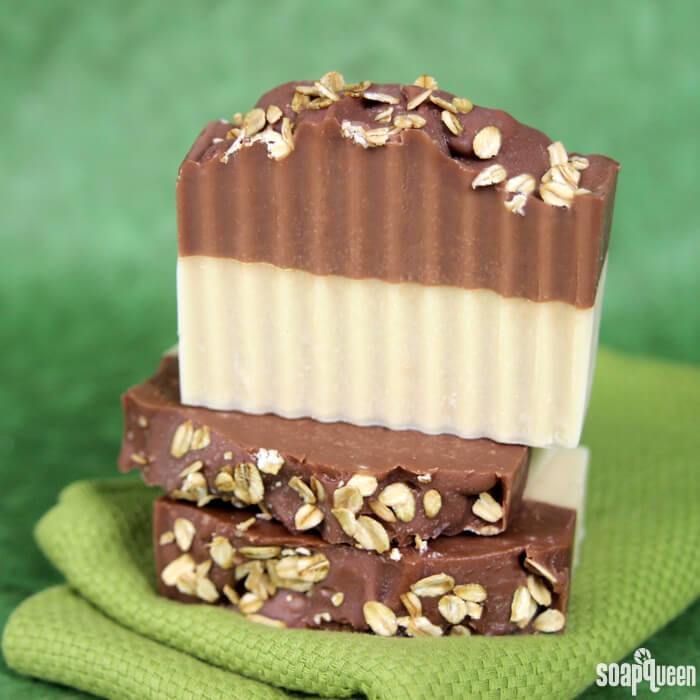
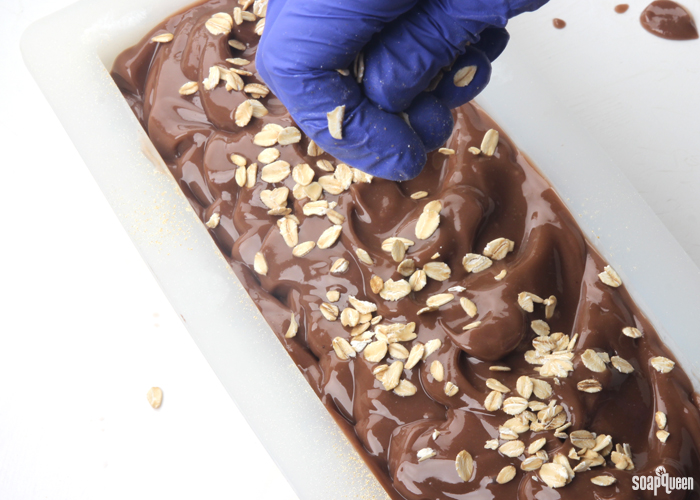
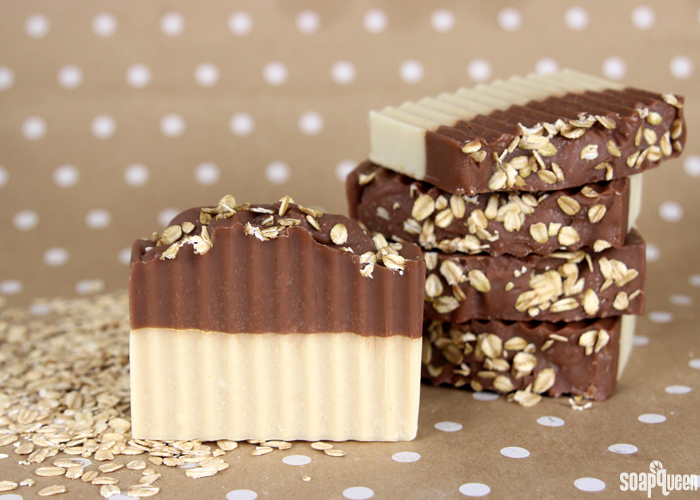

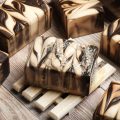
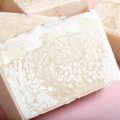
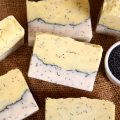

Hello! Quick question. Could I pre-disperse my colorants into sweet almond oil in a larger batch and store them for later use? I feel like I waste a lot of time/materials by mixing small, single-batch amounts of colorant every time I use them. It would be ideal if I could just grab a container of a pre-mixed color and add however much I need. Thanks!
You sure can! Store the colorants and oil in an airtight container in a cool, dry area. They will last as long as the oil shelf life. Make sure to mix well before each use as the colorants can settle. 🙂
Find a list of oil shelf lives here: http://www.soapqueen.com/bath-and-body-tutorials/tips-and-tricks/free-beginners-guide-to-soapmaking-common-soapmaking-oils/
-Kelsey with Bramble Berry
I thought all the lye was dissolved but apparently it wasn’t. Ugh. When I poured the lye into the oils I saw a few flakes at the bottom of the container. I was careful to not let those few flakes fall into the oil. But now I’m concerned. What if a flake fell into the oil? Will it dissolve? The batch is still in the mold. I can test the ph but my concern is that there may be a solid flake inside. Please advice. Thanks.
Hi Nitza!
Oh no, I’m sorry about that! I’ve had that happen before too. If a lye flake did sneak in, you will likely see it in the final bar. It can create a pocket or discoloration, or can sometimes leak from that area. After about 5 days, pH test that soap to be extra careful. If you notice anything weird in the bar, check that too. As long as it’s around 9-10 pH you should be fine!
Read more about pH testing soap here: https://www.soapqueen.com/bath-and-body-tutorials/tips-and-tricks/troubleshooting-lye-heavy-soap/
For your next batch of milk soap, you can pour that lye mixture through a strainer as an extra step. Even with a ton of mixing those flakes can be stubborn. The strainer ensures none of the flakes end up in your batch. 🙂
-Kelsey with Bramble Berry
Of course, a strainer. That’s would have been perfect. But for next time, can I just mix the powdered milk with some of the warm water and add it to the oil? In Anne-Marie’s Book Pure Soapmaking, the “Cow Milk in-the-Pot Swirl” recipe has the milk warmed to 90 deg. then added at light trace. If I can make the oatmeal recipe that way, it would be much easier and safer. What do you think? Can I make this recipe that way?
You can! Some soapers like to add milk at trace to cut down on some of the prep work. Just make sure to account for the milk added at trace and discount the water so it’s not too wet. Then, pop those soaps in the fridge or freezer for 5-24 hours to prevent scorching. 🙂
This book has more methods for working with milk: https://www.brambleberry.com/E-Book-Making-Milk-Soap-from-Scratch-P5257.aspx
-Kelsey with Bramble Berry
Thank! 🙂
You’re welcome! 🙂
Kelsey, I’ve made this soap a few times now and they came out perfect. But my recent batch scorched. I don’t know what I did wrong. What are your thoughts? I’d like to try again soaping at a lower temp. What’s the lowest I should go?
Milk can scorch when it gets too hot. To prevent that, it helps to freeze your lye into cubes before adding the lye. Then, keep your lye container in an ice bath so it stays cool the whole time. You’re looking for temperatures around 80F for the milk and around 120-130F for the oils. Once your soap is made, pop it in the freezer for 24 hours so it stays cold. 🙂
Learn more about working with milk here: http://www.soapqueen.com/bath-and-body-tutorials/tips-and-tricks/how-to-add-lye-to-milk-for-cold-process-soap/
-Kelsey with Bramble Berry
What is the shelf life of cured goat’s milk soap?
The shelf life will depend on the oils used in your recipe! For instance, if the recipe has hazelnut oil, the soap will last about 3 months because that’s how long hazelnut oil lasts. After that time it will go rancid. If your recipe contains longer-shelf life oils, it will last longer. 🙂
Read more about the shelf life of soap here: https://www.soapqueen.com/bath-and-body-tutorials/tips-and-tricks/shelf-life-bath-products-ingredients-rancidity-vs-mold/
-Kelsey with Bramble Berry
Hello! I want to use a crinkle cutter to cut these soaps as you have, but do you have any tips as to how you prevented the brown from dragging into the white when cutting this way? Not sure how y’all pulled that off? Thanks in advance!
Hi Laura!
The key is to make sure the soap is fairly firm before cutting! That will ensure the brown doesn’t drag into the white. That will take about 4-5 days, maybe longer depending on how soft the soap is. It should be firm to the touch and not dent or leave residue when touched. Then, make sure there are no pieces of oatmeal under the cutter. That will prevent oatmeal drag marks. 🙂
-Kelsey with Bramble Berry
So I know your recommended usage for the powdered goat’s milk is 1 oz per 8 oz or water. And the recipe calls for 11.5 ounces of water plus 1.5 oz of goat’s milk powder. So if I were using goat’s milk that I bought at the grocery store and already froze instead of powder and water should I just be measuring 13 ounces? The recipe didn’t have a “total goat’s milk” in case we weren’t using powdered so I just wanted to make sure. (even if the question sounds silly lol)
Hi Simone!
Not a silly question at all! That is correct. If you’re using liquid goat milk, you’ll want to use 13 ounces for this recipe. 🙂
-Kelsey with Bramble Berry
Newbie question as well , I’m using raw goats milk so does that apply to the 13 oz ? And is that in weight or liquid measure ?
Hello,
So I Would like to make this soap but I do have some newbie questions.
Because is a oatmeal soap, can I add “fresh oats” in my soap as a scrub and how much? and
how much can I add of honey? I mean the fragrance is called “Oatmeal, Milk and Honey” so why not plus they are awesome in your skin.
You can add oats to this soap to exfoliate! You’ll want to add the old-fashioned rolled oats, not instant oats. I would recommend starting with about 1 teaspoon per pound of soap. If you want more, you can add from there. 🙂
You can add honey as well! I would recommend 1 teaspoon per pound of soap for the honey as well. The natural sugars in honey can heat up and scorch in the soap, so I would recommend keeping it in the freezer for a full 24 hours to prevent any scorching. Read more about working with honey here: https://www.soapqueen.com/bath-and-body-tutorials/tips-and-tricks/adding-honey-to-cold-process-soap-tips-tricks-recipe/
-Kelsey with Bramble Berry
Sounds good, but when should I add the oat and the honey?
You can add both of those ingredients at thin trace (when the soap is just emulsified)! If you want your soap a bit thicker before pouring into the mold, hold off on adding the oatmeal until it’s as thick as you want it. That way it will suspend the oatmeal and you won’t pulverize the pieces with a stick blender trying to thicken it. 🙂
Learn more about trace here: http://www.soapqueen.com/bath-and-body-tutorials/tips-and-tricks/trace/
-Kelsey with Bramble Berry
Thank you very much Kelsey!
You’re welcome Yenisse! 🙂
Hi! I’d love to make this soap but don’t use fragrance oils. What essential oil(s) would you recommend for a similar effect/smell? Thanks!
Hi Laura!
Balsam Peru essential oil has a rich scent reminiscent of vanilla. I think it would be really nice in this recipe! You could also add a touch of cinnamon leaf essential oil to give you that warm comforting smell. 🙂
Balsam Peru essential oil: https://www.brambleberry.com/Balsam-Peru-Essential-Oil-P4443.aspx
Cinnamon leaf essential oil: https://www.brambleberry.com/Cinnamon-Leaf-Essential-Oil-P3641.aspx
This post has more great information about how to blend essential oils: https://www.soapqueen.com/bath-and-body-tutorials/tips-and-tricks/how-to-blend-essential-oils-safely/
-Kelsey with Bramble Berry
Thanks Kelsey! One more question: will those essential oils be sufficient with the brown oxide to give it that nice brown color shown? I know in the recipe it says the vanilla in the fragrance oil contributes to the color, so I want to make sure I’ll still get that color without it. Thanks again!
Hi Laura!
In this project, the fragrance does help contribute to a rich brown, but the majority of the color comes from the brown oxide. In cold process soap, it’s a “what you see is what you get,” type of coloring process. My guess is that the brown oxide and essential oils will give you a nice rich color, but you can always add a little more brown oxide if it doesn’t look dark enough in the bowl. I hope this helps!
-Amanda with Bramble Berry
Could someone tell me if all the measurements in this recipe are by weight or volume?
Hi Carrie!
The oils, lye and milk in this recipe are measured by weight! We find that’s a bit more accurate for soaping. The colorants and oatmeal are measured by volume. It’s a bit easier to measure them by volume because they’re such small amounts. 🙂
Read more about weight vs. volume here: http://www.soapqueen.com/bath-and-body-tutorials/tips-and-tricks/a-guide-to-weight-vs-volume/
-Kelsey with Bramble Berry
Good Morning!
I am new on the soap making, and have couple of questions;
1) What is the normal ratios to add colloidal oatmeal and Kaolin Clay to CP soap?
2) And at what stage should I add it, Oils or batter?
Hi Marianella!
For both of those, we recommend starting with about 1 teaspoon per pound. That’s a great general usage rate. Then, if you like, you can add more from there. 🙂
For the colloidal oatmeal, we recommend mixing the 1 teaspoon with 1 tablespoon of a lightweight liquid oil, like sweet almond oil. Then, you can add the dispersed oatmeal 1 teaspoon at a time. That helps prevent clumping!
With clay, we recommend mixing 1 teaspoon with 1 tablespoon of distilled water. That helps it mix in smoothly and prevents clumping as well. Read more about working with clays here: https://www.soapqueen.com/bramble-berry-news/sunday-night-spotlight-brazilian-clay/
We like to add both of those when the oils and lye are lightly emulsified. That’s called thin trace. Read more about trace here: http://www.soapqueen.com/bath-and-body-tutorials/tips-and-tricks/trace/
-Kelsey with Bramble Berry
Hello (:
Through Brambleberry.com the least amount of powdered goat milk you can purchase is 16 oz, which is enough to make 128 oz of goat milk! They recommend that you use it all within the first two months. What can you do to extend its life? Can you make all 128 oz and freeze it?
Also, is it better to use liquid goat milk (from a store) or powdered goat milk? What’s the difference between the two? Do both provide all the same benefits?
Thank you.
Hi there!
To extend that shelf life, you can make all 128 ounces and freeze it. That will keep it fresher for longer. If you like, you can freeze it in ice cube trays. That way it’s ready to go when you make milk soap. 🙂
Learn more about making milk soap here: http://www.soapqueen.com/bath-and-body-tutorials/tips-and-tricks/how-to-add-lye-to-milk-for-cold-process-soap/
I have used both powdered and liquid goat milk and haven’t noticed a huge difference in the feel of the bars. Both feel creamy and silky on the skin. You may want to make a small test batch with both to see which you prefer!
-Kelsey with Bramble Berry
Thanks for the help!
One more goat milk question (:
I’ve read that the consensus amongst many soapers is that there is little to no difference between goat milk soap and cow milk soap–but that it’s more popular to use goat milk because it has more “label appeal”. Have you used both and have you noticed any difference between the two?
We have used both! Personally, I haven’t noticed a huge difference between cow milk and goat milk. Both feel creamy, soft and moisturizing on the skin. We used cow milk in this cold process recipe: https://www.soapqueen.com/bath-and-body-tutorials/cold-process-soap/creamy-cow-milk-cold-process-tutorial/
We’ve also used coconut milk: https://www.soapqueen.com/bath-and-body-tutorials/cold-process-soap/lime-in-the-coconut-milk-cold-process-tutorial/
This would be another great opportunity to try them both and see what you think! I think they both feel amazing, but goat milk is popular at the moment. That one may be a little more beneficial from a marketing standpoint. 🙂
-Kelsey with Bramble Berry
Thanks Kelsey!
You’re welcome!
Hello again (:
I’ve read that you can just blend the powdered milk (the powder itself) into the oils/fats (after they’ve cooled some) to avoid scorching the milk, prior to adding the lye water–Is there a disadvantage to this? It seems waaaaay easier/less time consuming than preparing the milk, freezing it, then sloooowly adding the lye to it. Maybe this is mentioned in one of your tutorials?
Hi Daniel!
We recently interviewed Carmen with Earths Raw Beauty. She likes to do a 1:1 water lye solution, then add the remaining amount of liquid as fresh goat milk to her oils. She says it keeps it cool and saves time! You can read more about how she does that here: https://www.soapqueen.com/business/57348/#comment-241641
I haven’t personally tried that method, but it sounds nice and quick. I think it would work the same with powdered milk and is worth a small test batch!
We also have a great booklet that talks about several ways to add milk to your soap. You can find that here: https://www.brambleberry.com/Making-Milk-Soap-from-Scratch-P5252.aspx
-Kelsey with Bramble Berry
Thanks for the response Kelsey (:
Where I live, buying powdered goat milk is actually more expensive than buying regular goat milk so I think I’ll just stick with the freezing method, or maybe try Carmen’s–Do you think you can do an even lower ratio of water using her method?
My worry with a lower ratio than 1:1 is that the lye may not dissolve fully. I would recommend trying out a lower ratio to see. If you notice any cloudiness or leftover lye, you can add more water until it’s fully clear. 🙂
-Kelsey with Bramble Berry
I made this soap this afternoon. I made a larger batch (5 pound), so i upped the amount of powered goat milk that i put in my water (which i then froze). When i mixed my lye with my frozen ice cubs, it became thick. I’m wondering if i used to much goat milk? What would be your recommendation on, oz of powered goats milk per pound of soap?
Hi Jessie!
We recommend about 1 ounce of powdered milk per 8 ounces of distilled water. We’ve found that ratio creates a nice milk consistency! How much goat milk did you add to your water? Sometimes if the lye milk mixture gets hot, it can thicken as well. Let me know and we’ll get this figured out. 🙂
Powdered goat milk: https://www.brambleberry.com/Powdered-Goat-Milk-P4933.aspx
-Kelsey with Bramble Berry
I used 2.5 Oz of the powered goats milk in 18 oz of water. It stayed a nice white color, just got really thick. I took the soap out of the fridge this morning. Looks like it has set up nice, i’m just waiting to cut it in a few days. I have read with milk soap they stay softer longer.
Thanks!
That usage rate is actually right around what we recommend! I think that soap will be just fine. The milk will thicken a bit as you’re adding the lye – that’s natural. The milk fats are reacting with the lye and thickening slightly. You can see that in the Buttermilk Baby Bastile Bar video: http://www.soapqueen.com/bath-and-body-tutorials/cold-process-soap/buttermilk-bastille-baby-bar-on-soap-queen-tv/
The milk does make the soap a bit softer, so it will take at least 3-5 days to unmold and harden. Let me know how the soap looks when it’s cut! 🙂
-Kelsey with Bramble Berry
Hi I made this soap last night with frozen goats milk.
I made it that way you stated in the video add lye to frozen milk.
It was great and did not turn in color. But when I was blending it with the oils and adding the essential oils, I got a distinct ammonia odor. Will this go away when cured?
Thanks for any feedback!
Maria
Hi Maria!
That odor will go away as it cures! As the lye reacts with the milk, it will create that ammonia smell. It’s a bit surprising at first for sure! We found it went away after the 4-6 week cure though. 🙂
-Kelsey with Bramble Berry
Hi,
I made a batch of soap today that it was bigger than expected by the time I got my other mold ready my soap turned into play-doh looking in the containers. It was a 2 layers soap. I poured it out, or I should better say, I scooped it out and pressed it down with a spoon. It didn’t look good at all. It was way too thick. Now is resting in my molds.
What can I do? Is it going to waste?
This is the soap I made https://www.brambleberry.com/Gardener-Soap-W97.aspx
I am asking for help here because there is no comment area in the other page.
Thank you so much for any advice you can give me.
Hi Cinthia!
I think your soap should be just fine! As the soap sits, it will get thicker, and may have an unusual texture because of the loofah, pumice and coffee grounds. I’ve had some soap get quite thick on me as well! It turned into really nice bars though.
I would recommend checking the soap in a couple of days to see how it’s doing! Definitely let me know how it looks. 🙂
-Kelsey with Bramble Berry
Ok so, I’m a bit of an idiot and I didn’t notice where it specified the amount of colloidal oatmeal to use in the color prep section but I DID see where it says to add “all” the colloidal oatmeal to the batter. Since I got the oatmeal from Bramble Berry I thought ok, I guess they mean ALL. So… I put a full ounce in my batter. The soap set up, unfolded fine and looks ok, is my mistake going to have any bad repercussions?
Hi Lori!
I think your batch should be just fine! We dispersed the oatmeal to help it mix in easily, so there may be some clumps in the soap, and those clumps may feel a little grainy. That’s perfectly OK though, it will help exfoliate your skin! 🙂
-Kelsey with Bramble Berry
Awesome! Thank you. I am happy to say I’ve been bitten by the soaping bug and it’s almost all Anne-Marie and your team’s fault. 🙂 Thank you for all you do!
You’re very welcome Lori! Soapmaking is super addicting, that’s for sure. Have an awesome weekend. 🙂
-Kelsey with Bramble Berry
Hi,
Which is the right temperature of the milk to pour into the oils?
Thank you
Hi Cinthia!
You want your milk to be right around 70F. At 70F, it’s cool enough not to scorch, but not so cool that it hardens the oils in the pot. 🙂
Read more about working with milk in this post: http://www.soapqueen.com/bath-and-body-tutorials/tips-and-tricks/how-to-add-lye-to-milk-for-cold-process-soap/
-Kelsey with Bramble Berry
I may be missing something but I could not find anywhere in the recipe how much colloidal oatmeal is used…
At the end of the color prep section, 1tsp colloidal oatmeal dispersed in 1 tbsp light oil. This then gets mixed into the soap portion that will stay light colored (the portion in which the titanium dioxide is mixed in)
Hi Jin!
Anne is correct! We dispersed 1 teaspoon of colloidal oatmeal into 1 tablespoon of a light liquid oil. Then, we added all of that oatmeal dispersion to the white portion of soap. Sorry for any confusion! 🙂
-Kelsey with Bramble Berry
It’s only used to sprinkle on top.
Hi Martha!
We sprinkle oatmeal on top of these bars, but also add colloidal oatmeal to the soap itself! We love the way oatmeal feels in soap. It adds some great soothing properties. 🙂
-Kelsey with Bramble Berry
Hi,
So far I have only made hot process soap. I have seen a goat milk hot process recipe where the recipe called for 10 oz of water and they made the lye solution with 5 oz of water and added 5 oz of goat milk to the soap after it has cooked. Does the soap end up having the right PH balance after doing that? I was concerned that all of the water/goat milk solution needs to be cooked with the lye in order for it to be safe.
Another question that is sort of similar, if someone wants to add shea butter (or another butter/oil) to a soap recipe after it has cooked, for extra moisturizing properties, what is a good way to find out how much is appropriate?
Hi AJ!
If that milk is added after the soap is already cooked, it may not turn into soap. Because the soap in the pot is now at a 9-10 and won’t go through any more pH changes, the milk will remain milk and shorten that shelf life to just a couple of weeks. It’s similar to adding milk to rebatch soap.
To get the milk to saponify, or turn into soap, we would recommend adding it in the beginning. However, doing so can make it scorch. That causes discoloration and an unpleasant smell. Read more about working with milk here: http://www.soapqueen.com/bath-and-body-tutorials/tips-and-tricks/how-to-add-lye-to-milk-for-cold-process-soap/
I have heard of some soapers adding milk powder during the cooking process! That adds the silky feeling from milk, and ensures it still goes through saponification. That may be an option for you. 🙂
Powdered goat milk: https://www.brambleberry.com/Powdered-Goat-Milk-P4933.aspx
Also, it sounds like you’re wanting to superfat your soap! Superfat is oils leftover after the soapmaking process that aren’t turned into soap by the lye. They’re freefloating oils that add luxury to your batch.
To get that amount manually, take the amount of lye that you are supposed to use and multiply it with the following equation (1 – % superfat you want). So, if you wanted to an olive oil soap by 4%, you would do the following: (.134 oz. lye) x (1 – .04) = .1286 oz. lye. For a simpler version, you can do it this way: for a one pound batch of soap, a 5% superfat works out roughly to .8 oz. of extra oils per pound of soap.
You can also let our Lye Calculator do the work for you! It automatically calculates the superfat level for you, which means less math (I always enjoy that!)
Read more about superfat here: http://www.soapqueen.com/bath-and-body-tutorials/cold-process-soap/superfatting-soap-an-explanation-2/
Using the Bramble Berry Lye Calculator: http://www.soapqueen.com/bath-and-body-tutorials/cold-process-soap/using-the-bramble-berry-lye-calculator-2/
Hope that helps! 🙂
-Kelsey with Bramble Berry
Hi AJ,
I make hot process lactose free cow milk soap and do it almost the same as is done here at the beginning. I make this one for my baby niece who has extremely bad exzema, so there’s no added fragrances or colours to irritate her anymore than what’s already happening with her exzema. I freeze my milk, generally after I’ve just made a batch (in a container already weighed) so it’s ready whenever i need it next. That means it can be frozen anywhere up to a couple of months before I need it again but I also don’t have to worry about weighing it again as i always use the same mould for this soap.
To get the whitest creamiest looking soap I can I add some cold tap water to my sink and mix my lye/milk solution in here. It barely even heats up doing it this way for me. I leave it there until I’m ready to add it to the oils.
In my crockpot I add all my oils, I don’t melt down my coconut or palm oil I just add them solid to my soft oils. This is when I finally turn my crockpot onto the warm setting, add my lye mixture and start stirring with a spatula. Once the hard oils have almost all melted is when I use my stick blender. You know the rest of the hot procedure from here.
The only other thing I will add is if i decide to superfat I will add my oil after the cook is finished and directly before I mould it, just make sure its mixed well.
Hope this helps 😸
Thanks so much for sharing your technique Felicity! It sounds like an awesome bar of soap 🙂
-Amanda with Bramble Berry
Hi,
I cannot find Oat extract. Can I just skip this step or Can I substitute it for something else?
Thank you
Hi Cinthia!
You can leave the extract out if you like! You can also add another extract. Any extract would work great in this recipe. For instance, avocado extract would add some great moisturizing properties. You can add those extracts at the same amount as the oat extract. 🙂
Read more about extract options here: http://www.soapqueen.com/bramble-berry-news/sunday-night-spotligh-extracts/
You can also find oat extract at BrambleBerry.com: https://www.brambleberry.com/Oat-Extract-P4934.aspx
-Kelsey with Bramble Berry
My first milk soap – loved this, turned out beautifully! I made it exactly the same way with no changes including the crinkle cutter, and am just now able to start using my bars. It’s very gentle and leaves a nice conditioned feel to your skin. Plus, the scent of Oatmeal, Milk & Honey is just delicious and stays through curing. My bars are still a bit soft, so I might try salt next time I made these. Great recipe and looks yummy . . . definitely worth a try!
So glad you like the recipe Kim! I love these bars, they’re so nice and creamy. Also, as the bars continue to cure they will harden up. Sodium lactate helps harden the bars as well! You can add 1 tsp. per pound of oils to your cooled lye water. 🙂
-Kelsey with Bramble Berry
Sunday Night Spotlight: Sodium Lactate: http://www.soapqueen.com/bramble-berry-news/sunday-night-spotlight-sodium-lactate/
**Update**
I have made this soap a couple more times now, and really love how it leaves my skin. It’s a permanent recipe in my collection. It did, however, remain very soft for a long time, and one thing I do now is sub out 1 oz of both the coconut and olive oils, and add in their place 1 oz each of mango and cocoa butters. This firms the bar up nicely, making it usable much faster, and adds the benefits of butters. Try that if you want a variation on making it harder.
That’s awesome Kim, so glad you love this recipe! Adding those butters is an awesome idea. They can add some firmness. Also, who would want to wash with a creamy goat milk and butter soap? 🙂
-Kelsey with Bramble Berry
Mango butter: https://www.brambleberry.com/Mango-Butter-P3221.aspx
Cocoa butter: https://www.brambleberry.com/Cocoa-Butter-Pastilles–P3218.aspx
Can I switch the water out with milk on any recipe.
Hi Sim!
You can! Our Lye Calculator recommends a “liquid” amount in the recipe. You can use any liquid you like, including water, milk or tea! 🙂
Using the Bramble Berry Lye Calculator: http://www.soapqueen.com/bath-and-body-tutorials/cold-process-soap/using-the-bramble-berry-lye-calculator-2/
We recommend freezing that milk before adding your lye. That prevents the milk from scorching, which can cause discoloration and an unpleasant odor. Learn more in the How to Add Lye to Milk for Cold Process Soap: http://www.soapqueen.com/bath-and-body-tutorials/tips-and-tricks/how-to-add-lye-to-milk-for-cold-process-soap/
-Kelsey with Bramble Berry
Would like to make the goat milk cold process soap, thought I had every thing I needed , but was checking the recipe and I have palm kernel oil, can I use this instead of palm oil? Please let me know. Joan
Hi Joan!
I believe palm kernel oil is a soft oil, while palm oil is a hard oil. That means you can use palm kernel oil, but the recipe will be a lot softer. To help make the soap a little more firm, you can use tallow or palm kernel flakes. Read more in the How to Substitute Oil in Cold Process soap post: http://www.soapqueen.com/bath-and-body-tutorials/tips-and-tricks/how-to-substitute-oil-in-cold-process-recipes/
You can also add 1 tsp. of sodium lactate per pound of oils to your cooled lye water. That helps that soap firm up faster. 🙂
Sunday Night Spotlight: Sodium Lactate: http://www.soapqueen.com/bramble-berry-news/sunday-night-spotlight-sodium-lactate/
-Kelsey with Bramble Berry
Hi, how do I incorporate honey in this recipe?(how much, when to add etc)
Hi Dee!
We recommend adding honey at trace (when your oils and lye water are lightly emulsified). You can start out with about 1 tsp. of honey per pound of soap, and add more if you like. Then, you may want to store your soap in the fridge or freezer. Honey has natural sugar which can overheat soap.
That natural sugar does contribute to a fun lather though! 🙂
-Kelsey with Bramble Berry
Soi noticed a lot of your recipes call for palm oil. What can i use to substitute that? Using palm oil is a major major player in the death of orangutans since palm trees are part of their natrual habitat.
Thanks!
Hi Megan!
Palm oil adds some great firmness to your soap, and there is no direct replacement for it. You can leave it out of your recipe though! We have a lot of great palm free recipes you may like. I’ll include links below. 🙂
Palm Free Vertical Twist: http://www.soapqueen.com/bath-and-body-tutorials/cold-process-soap/palm-free-vertical-twist-tutorial/
Palm Free In The Pot Swirl: http://www.soapqueen.com/bath-and-body-tutorials/cold-process-soap/a-palm-free-in-the-pot-swirl/
Formulating Cold Process Recipes: http://www.soapqueen.com/bath-and-body-tutorials/tips-and-tricks/formulating-cold-process-recipes/
Because palm oil adds firmness, recipes without it can take longer to unmold and cure. To speed this process up, you can add 1 tsp. of sodium lactate per pound of oils to your cooled lye water. Read more in the Sunday Night Spotlight: Sodium Lactate: http://www.soapqueen.com/bramble-berry-news/sunday-night-spotlight-sodium-lactate/
Also, we only purchase palm oil from the Roundtable for Sustainable Palm Oil, also known as the RSPO.
The RSPO was founded in 2005 to create a system for certifying sustainably grown palm oil, and to create guidelines of membership for certified growers. These guidelines cover more than just environmental stewardship – members of the RSPO must report on and provide better working conditions, better wages, and foster local discussions and input on their impact on local and native land. These principles and criteria for members of the RSPO help ensure that the certified palm oil is produced under legal, socially and environmentally responsible management.
You can read more here: http://www.soapqueen.com/business/on-palm-oil/
-Kelsey with Bramble Berry
Dear SoapQueen,
Are you sure about adding the whole 2 oz FO to the brown part? I made it yesterday and it is still as soft as when I put it in the mold. I know it is a very young soap, but I am used to my soaps being almost hard enough to unmold the day after they are made. I will hold this soap in the mold for at least the five days you advised. I hope it will all be alright then.
Just for comparison:
I made another soap yesterday, without any colorant or FO, intended for a rebatch project. That soap left the mold after 12 hours (with leaving a few pieces of soap in the mold in de corners).
With kind regards,
Annemieke
Hi Annemieke!
That fragrance amount is correct! We wanted that soap to smell nice and strong, so we added the full amount to the brown layer. That’s because Oatmeal Milk and Honey Fragrance Oil discolors, and we wanted the bottom layer to stay nice and white. 🙂
Oatmeal Milk and Honey Fragrance Oil: https://www.brambleberry.com/Oatmeal-Milk-And-Honey-Fragrance-Oil-P3931.aspx
This soap will need to stay in the mold a little longer. The added fat in the milk makes the soap softer than if you had added distilled water. While it does need more time to firm up, we think the luxurious feeling of the milk is totally worth it!
Sodium lactate helps as well. Adding 1 tsp. of sodium lactate per pound of oils to your cooled lye water helps the soap pop out of the mold faster. 🙂
Sunday Night Spotlight: Sodium Lactate: http://www.soapqueen.com/bramble-berry-news/sunday-night-spotlight-sodium-lactate/
You can also do a mixture of goat milk and distilled water, or decrease the superfat level. That will help the soap harden faster as well!
-Kelsey with Bramble Berry
Hi Kelsey,
The milk in this recipe is totally worth it, indeed… I wanted to try making milk soap for a while and made a few recipes in April that I used this month (this soap is now 8 weeks old). After a few easier soaps (no color and/or unscented) this two-layer recipe was my goal. This recipe makes a very nice soap. All recipes have a very nice lather & the soap from this recipe ended up harder than the other recipes I have made with milk. The brown part is a littlebit softer than the white part, I guess that is due to the FO added giving the brown part a higher fat content than the white part?
I left the soap in the mold for more than a week before unmolding it. After a few more weeks the soap was hard enough to cut. Can the long set up/drying time be caused by a very light trace? My former recipes tended to set up too quick for me to play with color or different scents therefor I poured the moment I recognized trace. That’s another lesson I learned: when working with more layers, the layer underneath may be a bit harder for easier pouring of the second layer :). There is soooo much to learn when making soap.
With kind regards,
Annemieke
Hi Annemeike!
So glad you’re enjoying the soap! The bottom layer will be a bit softer at first. That is because of the extra oil added. However, both layers will firm up as the soap cures.
Also, soaps at thicker trace will set up faster. This is also the case with soaps that go through gel phase. During gel phase, the soap gets very hot – up to 180F. That helps speed up the saponification process, helping that soap harden more quickly. Read more about gel phase here: http://www.soapqueen.com/bath-and-body-tutorials/tips-and-tricks/gel-phase/
Because your soap was a bit thinner and needs to be frozen afterward to prevent scorching, it will take longer to unmold. Also, milk does make a softer bar, which takes longer to set up as well. We think the extra time is totally worth it though. 🙂
Also, that’s correct – having a thicker first layer will prevent the second layer from breaking through. That will give you nice even lines! Soapmaking is a complex process for sure. I’m still learning new things all the time. 🙂
-Kelsey with Bramble Berry
Do you ever add the powdered milk to either the cooled lye water or at trace? Would doing that allow you to avoid freezing the milk in order to mix it with the lye?
Hi Jane!
You can add the powder at trace if you like! Many hot process soapers like to do that to help avoid scorching. Just make sure to pop your mold in the fridge or freezer afterward so it doesn’t get hot and scorch the milk. 🙂
Adding the goat milk powder to your lye water can be a bit trickier. When you add the powder, the lye can start to heat up again as it reacts with the fat in the milk. I’m not sure if it gets hot enough to scorch. In that case, it may be easier to freeze your goat milk beforehand.
A small test batch would be helpful either way! 🙂
-Kelsey with Bramble Berry
Why did you want to avoid gel phase? Is it because of the milk or is it just an aesthetic preference? How do you know when you should go through gel phase or not?
Hi Chelsea!
During gel phase, your soap can get very hot – up to 180F! If that happens the milk can scorch, causing your soap to discolor and smell unpleasant. Putting it in the freezer will prevent that scorching. We recommend that for all milk soaps. 🙂
For soap made with water, it is personal preference if you want your soap to go through gel phase or not! Gel phase gives the soap a slightly shiny look, and makes the colors pop a little. It doesn’t change the soap at all, it’s just an aesthetic thing. Some soapers prefer it! The Jazzed About Gel Phase post has more great information on that: http://www.soapqueen.com/bath-and-body-tutorials/tips-and-tricks/gel-phase/
-Kelsey with Bramble Berry
That’s so funny that you are showing goat’s milk and oatmeal soap today, and I just made one yesterday!! With the same OMH FO, no less! Great minds think alike! 🙂
Here’s what I did again (I posted this earlier under the baby Bastille bar):
I used 11 oz Olive Oil, 9 oz Coconut Oil, 9 oz Palm oil, 4 oz Avocado Oil, 4.6 oz lye (6% super fat) and 10 oz of goats milk.
Does that sound good to you?
I did it the way you showed with frozen cubes and very slowly stirring the lye in. The temp. got to 75 and then started dropping to 70 again. It was in a bowl filled with ice the whole time. At that time I mixed it with oils which were at 99 degrees. It worked great, no darkening of milk at all. My design was that I left 1/2 plain, and in the other half added your OMH FO and ground oatmeal, and then layered them 4 times with cocoa powder pencil line in between them. Topped with whole oatmeal flakes. I put it in the fridge for about 4 hours, and it was already set. I unmolded today after 17 hours and it came out great out of your 10 in silicone mold.
Hi Martina!
How funny! I love the way the Oatmeal Milk and Honey Fragrance Oil smells in goat milk soap. It’s warm and comforting and luxurious. Great minds for sure! 🙂
-Kelsey with Bramble Berry
Oatmeal Milk and Honey Fragrance Oil: https://www.brambleberry.com/Oatmeal-Milk-And-Honey-Fragrance-Oil-P3931.aspx